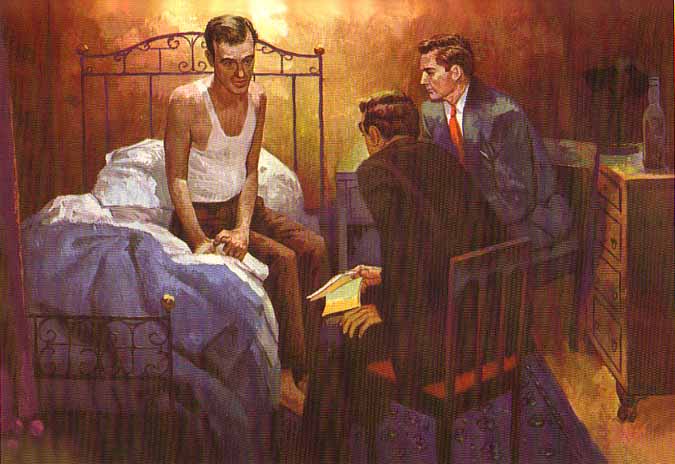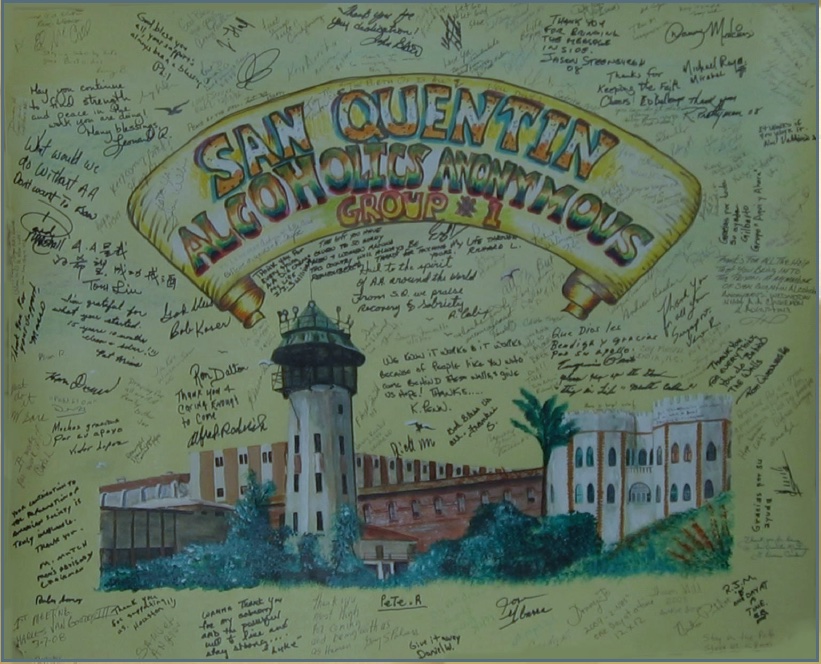“When a nation goes down, or a society perishes, one condition may always be found; they forgot where they came from.”
Carl Sandburg
The Northern California H&I Committee is a Ninth Tradition service committee of Alcoholics Anonymous, carrying the message of recovery to alcoholics in Corrections and Treatment facilities and facilities serving alcoholics. The initial spark of hospital work was set in motion on June 13th, 1935 when Bill W. and Dr. Bob (only three days sober at the time) made their first visit to a hospitalized alcoholic and thus found Bill D., the third member of A.A.1
Word of A.A.’s success had spread, and by 1942 San Quentin Prison Warden Clinton Duffy, recognizing that many of the inmates were incarcerated for reasons related to alcoholism, and concerned about the high rate of recidivism among alcoholics, realized the potential for A.A. to carry its message “behind the walls”. The visionary Warden Duffy contacted an A.A. member from the San Francisco Groups, who along with an inmate at San Quentin named Ricardo, in 1942 conducted one of the first known correctional institution meetings of A.A., reportedly with twenty members in attendance.2
An incident related by Warden Duffy in his book, The San Quentin Story, illustrates the early influence of A.A. in San Quentin:
- In their constant and over-ingenious quest for alcohol, several prisoners had consumed a highly toxic printing fluid containing wood and grain alcohols and various commercial solvents.
- As the symptoms of their poisoning began, they were brought to the prison hospital and harrowing hours followed, during which several of them died. The whole prison was tense as the fatalities continued to mount.. The San Quentin A.A. Group volunteered instantly and spent the rest of that long night and the next two days donating blood, foregoing meals and tirelessly assisting the overworked doctors administer treatment to their fellow alcoholics.. Previously A.A. hadn't been any too popular, but now prison support for A.A. hit an all-time high and stayed there. Many of the survivors joined up. The first Prison Group had made its mark; A.A. had come to San Quentin to stay.3
With regular meetings in San Quentin the parole figures suddenly dropped from the usual return rate of 80% to a remarkable 20%4 and held that way5. Seeing this success, Folsom Prison also clamored for AA and in 1943, in an unprecedented action of the Prison Board, inmate Ricardo volunteered and was permitted to transfer from San Quentin, a relatively progressive medium security facility to Folsom Prison, a hardened maximum security facility just north of Sacramento, for the sole purpose of helping to start A.A. there6. A.A. work in jails, prisons and penitentiaries began to take hold in Northern California as well as in other states across the country, and later that year Bill W. visited Northern California and was a guest speaker at both prisons, an experience which he found profoundly moving.7
Enthusiasm among A.A. members on the outside to participate in this type of service work grew rapidly. Rumor has it that when two groups from different cities showed up at the same time to conduct the evening’s meeting, the result was an altercation in the prison parking lot to determine who would go in - perhaps not the most spiritual way to decide the issue. This was before the existence of the A.A. General Service structure as we now know it, so in order to coordinate and organize the efforts of the many volunteers who wished to participate, our Committee was officially formed in 1946.
Since those pioneering days, the Northern California H&I Committee has evolved into a fully functional, independent service committee, with over 40 local areas represented and thousands of volunteers participating in our service work. As of 2013, Northern California H&I provides almost 42,000 meetings a year, serving 22 major state and federal institutions and hundreds of local jails, hospitals, rehabilitation/recovery centers and other community facilities.
One of the greatest factors in our success has been the implementation of our Pink Cans. Until 1957, volunteers had to either provide the literature for H&I meetings themselves or beg it from their groups, often stretching the group’s funds beyond their ability to pay for other A.A. services. Once again, God supplied the inspiration – why not pass a special can for contributions, entirely separate from the Seventh Tradition and solely for the purpose of providing the much needed literature? Oh, and we’ve got a bunch of PINK paint around.... The irresponsible had found another way to become responsible, common sense became uncommon sense and the solution has provided A.A. literature for confined patients and inmates for over 50 years, without detracting from the groups’ Seventh Tradition responsibilities. As a result of the funds available from the Pink Cans, the Northern California Hospital & Institution Committee has for many years been one of the largest purchasers of literature from the A.A. General Service Office in New York, thereby contributing greatly to A.A. World Services income.
The question is often asked, “Now that A.A. has a fully developed General Service structure, with its own Corrections and Treatment Committees, why should NorCal H&I remain a separate, independent service structure?” Firstly, due to the above- mentioned funding structure of the Pink Cans, NorCal H&I has the financial resources and the ability to purchase literature that would otherwise put a severe strain on our World Service funds to match. Our Committee is answerable and responsible to those who fund us through the Pink Cans – the A.A. groups of Northern California. Secondly, and perhaps even more important, our committee pre-dates the General Service structure, giving us the many blessings of over 70 years’ experience in carrying the A.A. message to alcoholics. We work closely with and are always ready to assist our brothers and sisters in General Service, and they with us; we are often asked to serve as consulting members of their committees, and we maintain a relationship built on mutual respect and common purpose.
An enduring legacy - in an article for the special issue of “The A.A. Grapevine” commemorating A.A.’s twenty-fifth anniversary, Warden Clinton Duffy, who was by then a member of the California Parole Board, said the following of Alcoholics Anonymous in prisons:
- “The A.A. program is presented in a humble and humane manner, without high-pressure frills. This is the approach necessary to reach the man who has developed a highly suspicious nature. It helps him to face truth and reality, without self-pity or dodging of responsibility. It rids him of fears, hates, jealousies and suspicions that have been his for so long. He learns to eliminate his drinking – to fight the urge, the desire – to get help and Fellowship from his A.A. friends.”8
In 2005 the 25-millionth copy of the book Alcoholics Anonymous was presented to Jill Brown, Warden of San Quentin Prison, in commemoration of the historic role San Quentin played in the development of Hospital and Institution work in A.A.9
1 AA Comes of Age, p. 72. AA World Services, Inc.
2 Ibid., p.89
3 Duffy, Clinton T. The San Quentin Story, pp 169-170. Doubleday & Co., Inc.
4 AA comes of Age, p. 90
5 AA Archives, Vol. 31, #1 (this writing indicates the rate may have stayed closer to 25-40%, still a spectacular drop)
6 Ibid., and Clinton T. Duffy article, reprinted AA Grapevine, July 2001
7 AA Archives, Vol. 31, #1; also Pass It On, p.289. AA World Services, Inc.
8 The AA Grapevine, June 1960, “I Didn’t Want To...”
9 www.aa.org, FAQS about AA History

